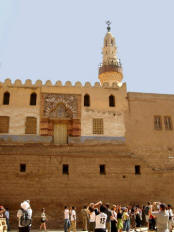Page 1 2 3 4 5 6 7 8 9 10 11 12 13 14 15 16 17 18 19 [History] Friday, 13 April. We got up at 3:15 and immediately put our luggage out. We were at breakfast at 3:30 and on the bus at 4:15. The bus got to the airport at 5:00 for our 6:30 flight to Luxor. It took just an hour to reach Luxor, on the east bank of the Nile 340 miles south of Cairo. This was the ancient city of Thebes, three times the capital of Egypt. Because our ship wouldn't be ready for boarding until later, buses took us directly to the Temple of Luxor for a two-hour tour. We got there about 8:15. Salah said this was a small temple, but it seemed very large to us (623 by 181 feet). Since it was our first temple, he took the opportunity to explain the layout of Egyptian temples generally, since they all followed a similar plan. Of course, many of them also had distinctive features. Generally, the temple entrance was in the center of a pylon (thick, sloping front wall) decorated with battle scenes of a pharaoh. Inside was a large courtyard open to the masses. Moving inward, there was a colonnade leading to a second, smaller courtyard, then a narrower colonnade or corridor leading to a still smaller courtyard, access to which was limited to important people. Then a narrower passage led to a "sanctuary" to which only the pharaoh or the high priest had access. [Note: In describing our visits to the various Egyptian temples, I won't even try to provide their history or dates because most of them were built, modified, or enlarged by various pharaohs over many centuries. Nor do I plan to discuss the various gods to which the temples were dedicated. All that information is readily available on the Internet. Perhaps I should also mention here that the English spelling of Egyptian words or names often varies, particularly when they have been transliterated from Arabic script into the Roman alphabet.] The Temple of Luxor had been built right along the Nile, and even now was separated from it only by the highway. In front of the temple was a long processional way lined with sphinxes. It once was much longer and led all the way to Temple of Karnak across the city. A tall pink granite obelisk stood on one side of the temple entrance. It was originally one of a pair, but the other one was sent to Paris in 1835 and now stands in the Place de la Concorde.
Entering through the pylon, we were surprised to see a 13th century mosque (Abu Haggag) perched on top of the wall, 26 feet up. Salah explained that the temple had been filled to that level with silt over the centuries, and the mosque was at ground level when it was built. At that time there were houses at that level, too. We proceeded through the first courtyard, built by Ramses II and replete with statues of him. We then continued through the colonnade toward the second courtyard. This courtyard was older and less ornate. It was surrounded by "papyrus columns" [so called because they deliberately resemble a bundle of papyrus plants]. As we advanced toward the sanctuary, we found that this part of the temple had been altered considerably by the Romans. On one wall of the inner courtyard, there were frescoes covering the hieroglyphics carved into the rock wall. There was even a Roman sanctuary, though it was in addition to, not a replacement for, the traditional Egyptian sanctuary. The Luxor sanctuary was fairly simple, a series of hieroglyphic panels, but we later found that all the temples' sanctuaries varied greatly in their contents.
When we finished the tour, our bus took us to our ship, the
River Anuket, moored only a short distance away. We boarded at 10:40 and were
provided a snack until our cabin (#305) was ready about 11:30. Our luggage was
already there, too. We were able to unpack before the buffet lunch was ready at
noon. The cabins were noticeably larger than those on other river ships we had
taken. We were on the top deck, convenient to the lounge on the same deck, but
three flights above the dining room. Unlike most river ships we'd been on, the
Anuket had no elevator.
After lunch Jane rested while I explored the ship, picking up a book from the small library. Then I went ashore and walked half a block along the Nile in each direction to see what was nearby. There were just a few shops. Back on the ship, I found the two shops onboard, a jewelry store and a clothing store, just outside the dining room. I knew Jane wanted a galabeya (kaftan), so I looked through those. I found a black one that was just what she was looking for. (I pick out all her galabeyas!)
At 18:45 we attended a welcome briefing followed by the daily port talk in the ship's lounge, then had dinner at 19:15 in the dining room, three flights down. Afterward I took Jane to the clothing shop on board. Sure enough, she choose the galabeya I had already picked out. Our 20- year old grandson, Robbie, had admired a home-spun wool jellaba (same thing - different dialect) I'd bought in Morocco in 1972, so I decided to buy a galabeya for him, too. Also, we were close enough in size that I could wear it to the ship's upcoming galabeya party on the 17th. Both galabeyas needed alterations, but would be ready in time. Jane also purchased a head scarf to complete her costume. Then it was three flights back up to our cabin. It had been a long day and we were in bed by 21:30. | ||||||||







